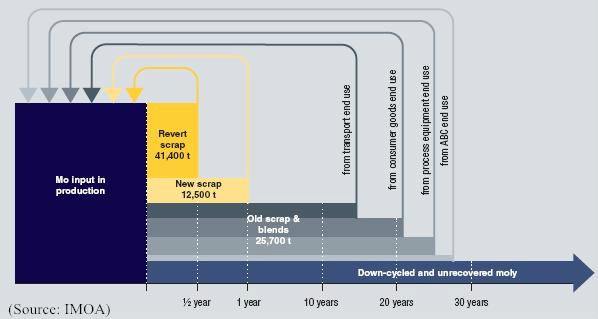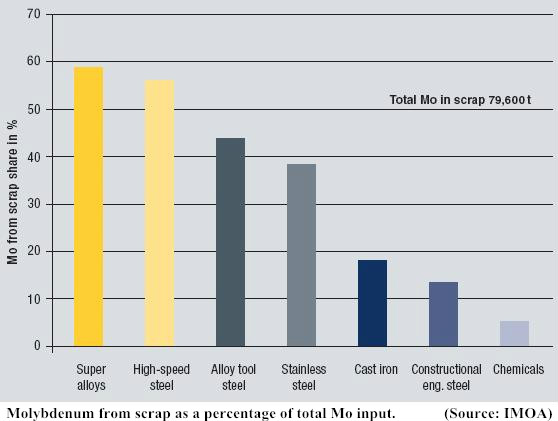 There are two sources of molybdenum: mining and recycling. A recent study found that about one quarter of the molybdenum used each year comes from recycling. Molybdenum scrap therefore plays an important part in meeting demand and contributing to sustainability.
There are two sources of molybdenum: mining and recycling. A recent study found that about one quarter of the molybdenum used each year comes from recycling. Molybdenum scrap therefore plays an important part in meeting demand and contributing to sustainability.- Recycling of scrap for the production of new materials requires less energy than the production of primary metal and it causes fewer emissions. It is also often sourced locally, so transportation routes are short. Therefore, molybdenum recycling can not only bring cost benefits but also environment benefits.
- At present, approximately 80% of molybdenum is used in the production of steels, thus it is mainly recycled from the steel industry. There are four major types of steel scrap:
- Revert scrap: This kind of scrap refers to remnants manufactured in the steelmaking process, such as cut-off ends or edge trimmings. This scrap is usually returned to the furnace and re-melted quickly after its generation.
- New (or first use) scrap: This scrap is generated by steel mill customers. It is mainly recycled by scrap collectors and processors, usually within half a year of its production in the steel mill.
- Old (or end use) scrap: Steel products at the end of their useful life are called old scrap. This kind of scrap is recycled by scrap dealers. The age of old scrap ranges from five years for some consumer goods to over 50 years for some building products.
- Blends: Blends refer to molybdenum units that come from a different scrap source than the product for which they are intended. For example, a blend intended for the production of Type 316 stainless steel may contain molybdenum from nickel-based alloy scrap. Scrap processors use special methods to create scrap blends that are tailored to the specifications of customers.

- (The molybdenum scrap reuse cycle for 2011. Of the 25% total scrap input, 13% was revert scrap with 4% each of new scrap, old scrap and blends.)
- About 60% of molybdenum scrap is used to produce stainless and constructional engineering steels. The rest is used to produce alloy tool steel, super alloys, high-speed steel, cast irons and chemicals.
- Stainless steels: About 40% of all molybdenum recycled is used to produce stainless steel. Stainless steel producers could use molybdenum almost entirely from scrap if there was enough scrap. However, the popular Type 316 stainless steel is produced using only about 38% molybdenum units from scrap. The balance comes from new primary molybdenum.
- Alloy steels: About 19% of all molybdenum scrap is used in the production of alloy steels. Most of the scrap used in alloy steel is revert scrap from the steel mill. Because the amount of molybdenum in engineering steel is less than 0.5%, the incentives for its recycling are low. Engineering steels are recycled and the molybdenum is therefore "down-cycle" into general steel production. Hence, primary molybdenum is the main source of molybdenum units for engineering steel.
- Tool steels and super alloys: Molybdenum recycled from scrap accounts for over 50% of molybdenum input in the tool steel and nickel-based super alloy industries. Scrap used in this field mainly comes from revert scrap, because of the large amount of scrap generated in the production process, and this in-house reuse is important for cost-control.


- The near future
- The ratio of recycled molybdenum to primary molybdenum used in the production of molybdenum-containing goods has fallen in recent years. In 2011, 25% of the total molybdenum usage came from scrap, compared to 27% in 2000. This is because the rapid growth of demand for molybdenum in this period outpaced the availability of scrap.
- The longer term
- The use of molybdenum recycled from scrap is expected to grow to about 110,000 tonnes by 2020, accounting for about 27% of all molybdenum use. By that time, scrap availability in China will increase to more than 35,000 tonnes per year. Currently, Europe is still the region with the highest first use of molybdenum scrap with about 30,000 tonnes per year. Contrary to the situation in China, however, Europe's use of scrap is expected to stay more or less the same proportion of the total until 2020. By 2020, about 55,000 tonnes of molybdenum will come from revert scrap, around 22,000 tonnes from old scrap and the rest will be split between blend materials and first use scrap. By 2030, molybdenum recycled from scrap is expected to account for 35% of all molybdenum used, owing to the further maturing of the economies of China, India and other developing countries and an increasing emphasis on preserving resources and recycling valuable materials.
-
About us
Contact us
Make a suggestion
- Metalpedia is a non-profit website, aiming to broaden metal knowledge and provide extensive reference database to users. It provides users reliable information and knowledge to the greatest extent. If there is any copyright violation, please notify us through our contact details to delete such infringement content promptly.
 There are two sources of molybdenum: mining and recycling. A recent study found that about one quarter of the molybdenum used each year comes from recycling. Molybdenum scrap therefore plays an important part in meeting demand and contributing to sustainability.
There are two sources of molybdenum: mining and recycling. A recent study found that about one quarter of the molybdenum used each year comes from recycling. Molybdenum scrap therefore plays an important part in meeting demand and contributing to sustainability.


